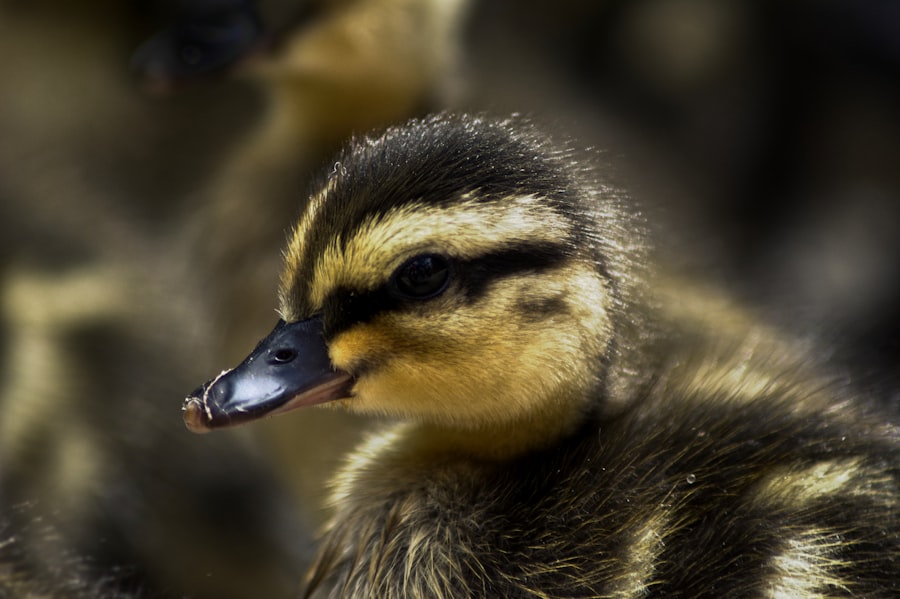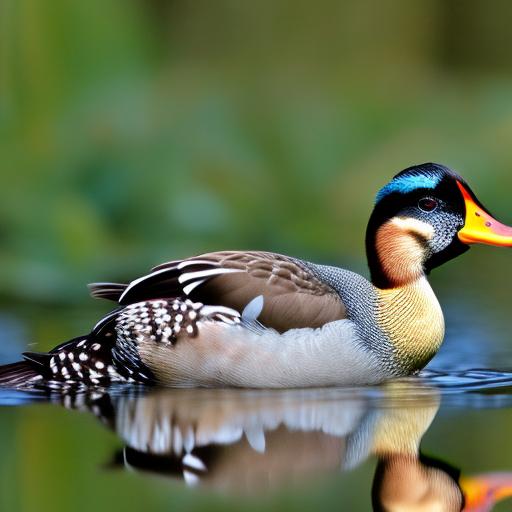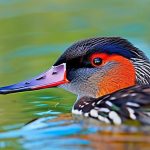Bantam ducks are small-sized ducks that are known for their adorable appearance and friendly nature. They are a miniature version of standard duck breeds, making them perfect for those who have limited space or simply want a smaller duck breed. Bantam ducks make great pets or additions to a farm due to their compact size, low maintenance requirements, and charming personalities.
Bantam ducks are often chosen as pets because of their small size and cute appearance. They are easy to handle and can be kept in smaller enclosures compared to standard duck breeds. Their small size also makes them less intimidating for children or those who may be afraid of larger animals. Bantam ducks are known for their friendly and sociable nature, making them great companions for both adults and children.
For those who have a farm, bantam ducks can be a valuable addition. They are excellent foragers and can help control pests such as slugs, snails, and insects. Bantam ducks also produce eggs, although they may not lay as many as standard duck breeds. However, their eggs are still delicious and can be used in cooking or baking. Overall, bantam ducks are versatile animals that can bring joy and usefulness to any home or farm.
Key Takeaways
- Bantam ducks are small-sized ducks that are popular among backyard poultry keepers.
- Bantam ducks originated in Southeast Asia and were brought to Europe in the 17th century.
- Bantam ducks have a compact body, short neck, and a round head with a short beak.
- Some popular breeds of bantam ducks include the Dutch, Japanese, and Silkie bantams.
- Bantam ducks are easy to care for, require less space, and are good foragers.
History and Origin of Bantam Ducks
The origins of bantam ducks can be traced back to Asia, particularly China and Japan. These miniature ducks were bred and developed over time to create the bantam duck breeds we know today. The exact timeline of their development is unclear, but it is believed that bantam ducks have been around for centuries.
Bantam ducks were initially bred for ornamental purposes due to their small size and attractive appearance. They were often kept in gardens or courtyards as decorative birds. Over time, they gained popularity as pets due to their friendly nature and ease of care.
In the 19th century, bantam ducks were introduced to Europe and the United States. They quickly became popular among poultry enthusiasts and breeders. Today, there are several recognized bantam duck breeds, each with its own unique characteristics and traits.
Physical Characteristics of Bantam Ducks
Bantam ducks are significantly smaller in size compared to standard duck breeds. While standard ducks can weigh up to 10 pounds, bantam ducks typically weigh between 1.5 to 3 pounds. Their small size makes them easy to handle and care for.
Bantam ducks come in a variety of feather colors and patterns. Some common colors include white, black, blue, silver, and buff. They can also have different patterns such as solid, mottled, or pied. The feathers of bantam ducks are often soft and fluffy, adding to their overall cuteness.
Another distinguishing feature of bantam ducks is their beak and leg color. While standard duck breeds typically have orange or yellow beaks and legs, bantam ducks can have a range of colors including black, gray, or even pink. This adds to their uniqueness and charm.
Popular Bantam Duck Breeds
There are several popular bantam duck breeds that are loved by poultry enthusiasts and pet owners alike. Here are some of the most well-known bantam duck breeds:
1. Call Ducks: Call ducks are one of the smallest bantam duck breeds, weighing around 1.5 pounds. They have a distinctive upright posture and a loud quack. Call ducks come in various colors including white, gray, and mallard.
2. Miniature Appleyard: Miniature Appleyard ducks are a smaller version of the standard Appleyard breed. They have a compact body and come in various colors such as silver, blue, and buff.
3. Silver Bantam: Silver bantam ducks are known for their striking silver plumage. They have a calm and friendly temperament, making them great pets.
4. Black East Indian: Black East Indian ducks are known for their unique appearance. They have shiny black feathers and a slender body. They are often kept for their ornamental value.
5. Buff Bantam: Buff bantam ducks have a beautiful buff-colored plumage. They are friendly and sociable, making them great pets for families.
Each bantam duck breed has its own physical characteristics and personality traits, making it important to choose the breed that best suits your preferences and needs.
Unique Features of Bantam Ducks
Bantam ducks have several unique features that set them apart from other duck breeds. One of their most notable features is their small size. Their compact size makes them easy to handle and care for, especially for those who have limited space or are new to raising ducks.
In addition to their small size, bantam ducks are known for their friendly and sociable nature. They enjoy human company and can become quite attached to their owners. Bantam ducks are often described as being curious and intelligent, making them entertaining pets.
Bantam ducks also have a unique quack that is often higher-pitched compared to standard duck breeds. Their quack is often described as being cute and endearing, adding to their overall charm.
Benefits of Raising Bantam Ducks

There are several benefits to raising bantam ducks, whether as pets or additions to a farm. One of the main benefits is their low maintenance requirements. Bantam ducks are relatively easy to care for and require less space compared to standard duck breeds. They can be kept in smaller enclosures or even in a backyard with proper fencing.
Bantam ducks are also useful in pest control. They are excellent foragers and can help control pests such as slugs, snails, and insects. This can be particularly beneficial for those who have a garden or farm and want a natural way to control pests without the use of chemicals.
Another benefit of raising bantam ducks is their egg production. While they may not lay as many eggs as standard duck breeds, bantam ducks still produce delicious eggs that can be used in cooking or baking. Their eggs are often smaller in size but are just as nutritious and flavorful.
Housing and Care Requirements for Bantam Ducks
When it comes to housing bantam ducks, it is important to provide them with a safe and comfortable environment. They should have access to a secure enclosure or coop that protects them from predators and the elements. The enclosure should also have a sheltered area where they can rest and nest.
Bantam ducks require less space compared to standard duck breeds due to their small size. However, they still need room to move around and exercise. A general rule of thumb is to provide at least 4 square feet of space per duck.
It is also important to provide bantam ducks with fresh water for drinking and bathing. They should have access to a shallow water source that allows them to dip their heads and clean their feathers.
In terms of diet, bantam ducks require a balanced diet that includes a mix of grains, vegetables, and protein. They can be fed commercial duck feed or a mix of grains such as corn, wheat, and barley. It is also important to provide them with fresh fruits and vegetables for added nutrition.
Breeding and Incubation of Bantam Duck Eggs
Breeding bantam ducks can be a rewarding experience for those who want to expand their flock or start a breeding program. To breed bantam ducks, it is important to have a male and female pair. The male, also known as a drake, will mate with the female, also known as a duck.
Once the female lays her eggs, they can be collected and incubated. Bantam duck eggs typically take around 28 days to hatch. It is important to provide the eggs with the proper temperature and humidity levels during incubation.
During incubation, it is important to regularly check the eggs for any signs of development. Candling can be done to check for the presence of a developing embryo. Once the eggs start to hatch, it is important to provide a warm and safe environment for the ducklings.
Nutrition and Feeding of Bantam Ducks
Bantam ducks require a balanced diet to ensure their overall health and well-being. They should be provided with a mix of grains, vegetables, and protein. Commercial duck feed can be used as a base diet, supplemented with fresh fruits and vegetables.
Grains such as corn, wheat, and barley can be fed to bantam ducks in moderation. These grains provide energy and help support their growth and development. It is important to avoid feeding them too many grains as it can lead to obesity.
Fresh fruits and vegetables should also be included in their diet. Leafy greens such as spinach and kale are rich in vitamins and minerals. Fruits such as apples and berries can be given as treats.
Protein is an essential part of a bantam duck’s diet. They can be provided with sources of protein such as mealworms, crickets, or commercially available duck pellets. Protein helps support their muscle development and overall health.
Health Issues and Common Diseases of Bantam Ducks
Like any other animal, bantam ducks are susceptible to certain health issues and diseases. It is important to monitor their health regularly and take preventive measures to keep them healthy.
Some common health issues that bantam ducks may face include respiratory infections, parasites, and foot problems. Respiratory infections can be caused by poor ventilation or exposure to cold and damp conditions. Parasites such as mites and worms can affect their overall health and well-being. Foot problems such as bumblefoot can occur if they are kept on hard or rough surfaces.
To prevent these health issues, it is important to provide bantam ducks with a clean and dry environment. Regular cleaning of their enclosure or coop is essential to prevent the buildup of bacteria and parasites. It is also important to provide them with proper nutrition and access to fresh water.
If a bantam duck shows signs of illness or discomfort, it is important to seek veterinary care. A veterinarian who specializes in poultry can provide the necessary treatment and advice.
Bantam ducks are adorable and friendly animals that make great pets or additions to a farm. They are small in size, making them easy to handle and care for. Bantam ducks come in a variety of colors and patterns, adding to their overall charm.
There are several popular bantam duck breeds, each with its own unique characteristics and traits. Bantam ducks have a friendly and sociable nature, making them great companions for both adults and children.
Raising bantam ducks has several benefits, including their low maintenance requirements, usefulness in pest control, and egg production. They can be kept in smaller enclosures or even in a backyard with proper fencing. Bantam ducks require a balanced diet that includes grains, vegetables, and protein.
While bantam ducks are generally healthy animals, they can still face certain health issues and diseases. It is important to monitor their health regularly and take preventive measures to keep them healthy.
Overall, bantam ducks are delightful animals that can bring joy and usefulness to any home or farm. Consider adding bantam ducks to your flock or family for a unique and rewarding experience.
If you’re interested in bantam duck breeds, you might also want to check out this informative article on poultrywizard.com about chicken coop interior ideas. Creating a comfortable and functional living space for your bantam ducks is just as important as it is for chickens. This article provides great tips and inspiration for designing the perfect coop interior. To learn more, click here.
FAQs
What are bantam duck breeds?
Bantam duck breeds are small-sized ducks that are bred for ornamental purposes. They are smaller in size compared to standard duck breeds and are popular among backyard poultry keepers.
What are some popular bantam duck breeds?
Some popular bantam duck breeds include Call ducks, Mandarin ducks, Wood ducks, Carolina ducks, and Silver Bantam ducks.
What is the average size of bantam duck breeds?
The average size of bantam duck breeds is around 1-2 pounds, which is significantly smaller than standard duck breeds.
What is the lifespan of bantam duck breeds?
The lifespan of bantam duck breeds is around 5-8 years, depending on their living conditions and overall health.
What is the purpose of breeding bantam duck breeds?
Bantam duck breeds are primarily bred for ornamental purposes, as they are smaller in size and have unique and attractive feather patterns. They are also kept as pets and for exhibition purposes.
What is the temperament of bantam duck breeds?
Bantam duck breeds are generally docile and friendly in nature, making them suitable as pets. However, like all ducks, they can be noisy and messy, and require proper care and attention.
What is the diet of bantam duck breeds?
Bantam duck breeds require a balanced diet that includes a mix of commercial duck feed, fresh vegetables, and clean water. They also require access to a pond or pool for swimming and exercise.
What are some common health issues that bantam duck breeds may face?
Bantam duck breeds may face health issues such as respiratory infections, parasites, and egg-laying problems. It is important to provide them with proper care and regular veterinary check-ups to ensure their health and well-being.
Meet Walter, the feathered-friend fanatic of Florida! Nestled in the sunshine state, Walter struts through life with his feathered companions, clucking his way to happiness. With a coop that’s fancier than a five-star hotel, he’s the Don Juan of the chicken world. When he’s not teaching his hens to do the cha-cha, you’ll find him in a heated debate with his prized rooster, Sir Clucks-a-Lot. Walter’s poultry passion is no yolk; he’s the sunny-side-up guy you never knew you needed in your flock of friends!







